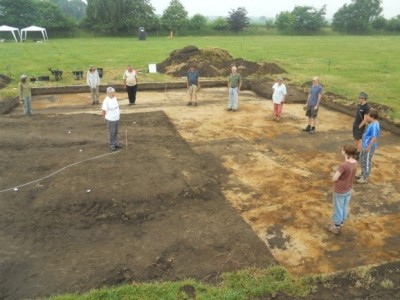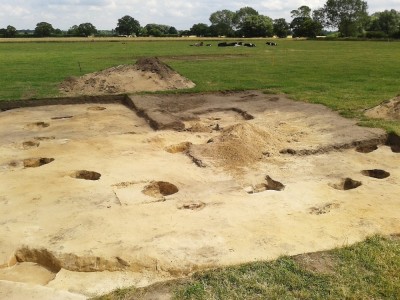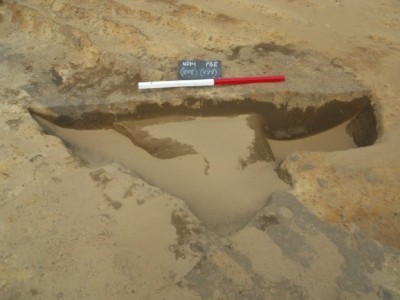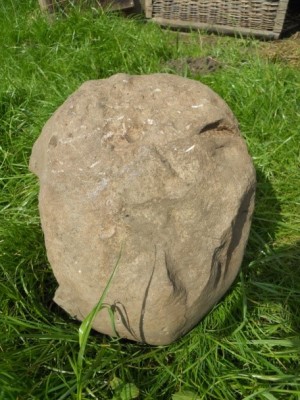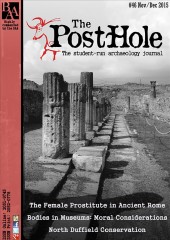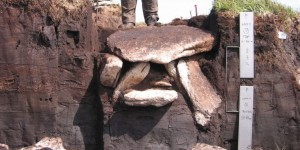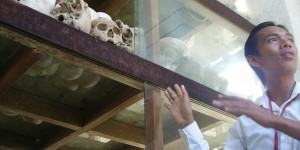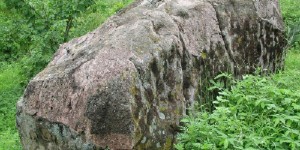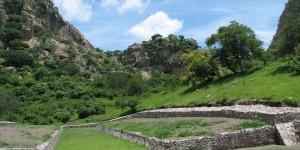This is the fourth in a series of articles concerning the activities of Archaeology North Duffield, the archaeology branch of the North Duffield Conservation and Local History Society, the other entries appearing in issues 13, 18 and 24. There have been two more seasons of excavation since the last report in 2012, and this brief report will give an update on the work, the findings and the current interpretation of the site.
In July 2013 and over June-July 2014 the site was revisited by the community team, hoping to reveal more of the circular feature that had been partially uncovered in the previous dig. In the first year of the project, the feature was thought to be a ring-ditch enclosure due to the lack of evidence for post holes. The more recent excavations together uncovered a complete ring ditch with an outer diameter of 20 metres, along with a series of pits approximately one third of the way towards the centre of the circle, clearly suggestive of post settings (see Figure 1). Unfortunately the entire site has been truncated by medieval and modern ploughing and no trace of floors or ancient ground surfaces remains.
The Round-house Structure
A large proportion of the ring-ditch was excavated over the two digging seasons (see Figure 2). It varied between 0.7m and 1.0m in width and between 0.2m and 0.3m in depth, with steep sides and a rounded base. The ditch fill contained a large number of sherds of Iron Age calcite gritted pottery, and, in the 2013 excavations, an as-yet-unidentified iron object bearing a resemblance to a spearhead. In addition to these finds, several pieces of iron slag were recovered, along with a single worked flint.
There were two gaps in the ring-ditch that have been interpreted as doorways or entrances into the structure. The larger of these gaps appeared on crop marks in the southeast segment of the ditch, and when uncovered in 2014 turned out to be approximately 6m in width. This is thought to be too large to be a practical doorway without some other form of protection from the weather, but it is likely that any evidence of a lighter, shallower-set ancillary structure such as a screen or windbreak will have been lost to ploughing if it ever existed. The terminals of the ring-ditch at this south-eastern entrance both held large numbers of presumed packing stones.
Just south of due west the ring-ditch was again broken, this time by a gap of just over 2m. The northern terminal at this entranceway was formed of a pit 0.6m deep and containing two large Sherwood sandstone boulders, interpreted as post packing, but there was no corresponding post-setting upon the other side of the gap: the ring-ditch terminal there was homogenous with the rest of the feature, although it also contained significant amounts of stone.
The series of pits within the circle formed an almost unbroken set respecting the curve of the ring-ditch, with considerable variation in depth and diameter, and most were half-sectioned with some eventually fully excavated (see Figure 3). They have been interpreted as post-holes due to their position roughly one-third of the distance from the outer ditch to the projected centre of the ring, consistent with other excavated round-houses in Britain (Harding 2009). This interpretation is further supported by the presence of packing stones or clay within a number of the features.
Overall, the ring-ditch encloses a floor area of roughly 241 metres, which places it at the upper end of round-houses in Britain in terms of size. Parallels from the Iron Age exist at Broxmouth, East Lothian (Armit and McKenzie 2013) and Whitton Hill, Northumberland (Harding 2009), along with a late Bronze Age example of similar size at Thwing in East Yorkshire (Manby 1984; 1985; 1986; 1991).
For the most part, the weather treated the site gracefully, but a long dry spell in 2014 coupled with strong winds (see Figure 4) made work more difficult.
Finds and Dating
The 2013 and 2014 seasons of excavation brought the total number of Iron Age pottery sherds up to 127, mostly recovered from within the ring-ditch, indicating a middle Iron Age date around 300 BC (Austin 2014). Along with these, 4 possible Bronze Age pottery fragments were discovered. A small number of Roman pottery sherds and a moderate quantity of medieval and later ceramics were retrieved from the plough soil.
Some 21 pieces of struck flint were collected over the entirety of the project, and analysis suggests a probable Neolithic date for the majority of the items (Makey 2015). However, the flints are likely residual and not related to the round-house itself.
Three fragments of burnt daub, still retaining the impression of the wattle upon which they were pressed, were recovered from the north-east area of the ring-ditch. Further quantities of clay that has been heat-altered—the clay no longer absorbs or dissolves in water, suggesting it has structurally changed—were retrieved from other areas of the ring-ditch, some with a flat facet suggesting they were associated with a structure. This could be a kiln or oven or even simply internal daub from the round-house wall.
There has been a variety of evidence suggesting the presence of iron-working at the round-house (Elsey 2015, 95-7). Lumps and fragments of slag were recovered from a number of contexts, as well as appearing in a previous field-walking exercise. Along with the previously-mentioned iron object, several ‘prills’, evidence of iron-smelting, were found in the ring-ditch fill. A large sandstone boulder was lifted from one of the terminals of the ditch at the southeast doorway that when placed on the ground sat firmly on one end. Its uppermost surface, in this position, was unnaturally pock-marked and showed indications of burning, and this has been suggested to be an ‘anvil’ (see Figure 5). However, no evidence for hammer-scale was found in any context.
Thanks to the Mick Aston Archaeology Fund, a grant was obtained to enable two charcoal samples from the ring-ditch to be carbon dated (Elsey 2015, 97-8). The first was dated to 2188 ± 29 BP (267-209 cal BC) and the second to 4495 ± 28 BP (2573-2517 cal BC). The former date coincides closely with the date of 300 BC suggested by the majority of the ceramic assemblage: mid-to-late Iron Age. The latter fragment may be residual, and related to the possible Bronze Age pottery fragments or the Neolithic worked flints. Either way, this evidence suggests human use of the site much earlier than was previously suspected.
Conclusions
So ends the third and final season of excavation at this enigmatic site. The project has widely been regarded as a success, both archaeologically and for the village community. While the dig has been a key part of recovering evidence, the project has also incorporated an Iron Age festival held on the village green in 2013, a conference on the Iron Age in 2014 that included presentations from a number of experts from Yorkshire and beyond, and finally the publication of a book just this year (Elsey 2015).
The excavation was very lucky to receive a visit from Dr Melanie Giles, Senior Lecturer in Archaeology at the University of Manchester, whose comments added considerably to the understanding of the site thanks to her extensive knowledge of the Iron Age in Yorkshire. Likewise, Dr Cath Neal from the University of York spent a day on site, both digging and sharing her considerable experience of Iron Age sites, suggesting a range of new possibilities. The attention and encouragement from experts such as these has provided invaluable encouragement to the team and the Society as a whole.
There is still some work to be done. Soil samples were taken and processed by wet-sieving, but the resulting environmental evidence has not yet been analysed. Anita Radini of York University has agreed to give the author a crash course in environmental sample identification early in 2016. The burnt daub recovered from the ditch fill is still awaiting investigation: if anyone can suggest an appropriate expert, please contact the author.
Bibliography
- Armit, I. and McKenzie, J. (2013) An inherited place: Broxmouth Hillfort and the south-east Scottish iron age. Edinburgh: Society of Antiquaries of Scotland.
- Austin, T. (2014) ‘Appendix D: North Duffield 2014 (ND14/F6E) excavation: ceramics report’ in B Elsey (2015) North Duffield: archaeology and the local community, 131-5. York: Quacks the Printers.
- Elsey, B. (2015) North Duffield: archaeology and the local community. York: Quacks the Printers.
- Harding, D W (2009) The iron age round-house: later prehistoric building in Britain and beyond. Oxford: Oxford University Press.
- Makey, P. (2015) ‘Appendix H: flint assessment’ in B Elsey (2015) North Duffield: archaeology and the local community, 143-6. York: Quacks the Printers.
- Manby, T. G. (1984) ‘The Thwing excavation 1983’, Yorkshire Archaeological Society: Prehistory Research Section Bulletin, 21, 1-4.
- Manby, T. G. (1985) Thwing: excavation and field archaeology in East Yorkshire. Unpublished interim report. Leeds: Yorkshire Archaeological Society.
- Manby, T. G. (1986) ‘Thwing 1985’, Yorkshire Archaeological Society: Prehistory Research Section Bulletin, 23, 2-6.
- Manby, T. G. (1991) ‘Project reports: Thwing 1990’, Yorkshire Archaeological Society: Prehistory Research Section Bulletin, 28, 6-7.


